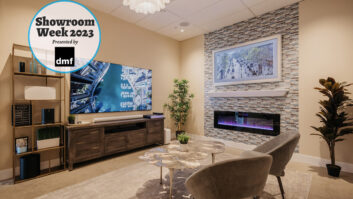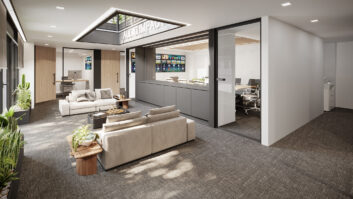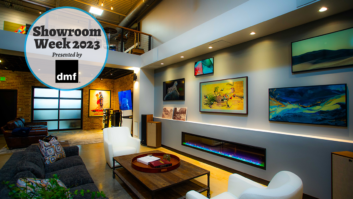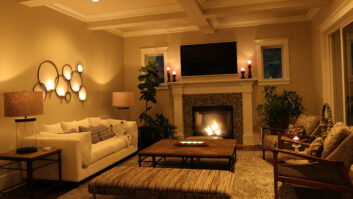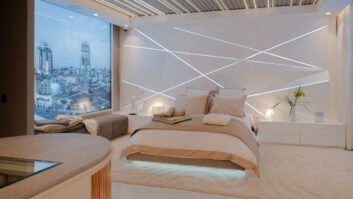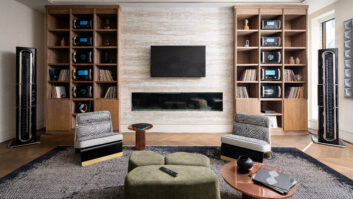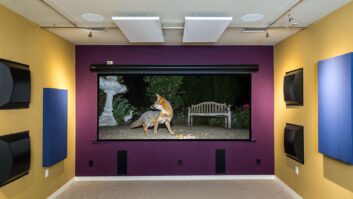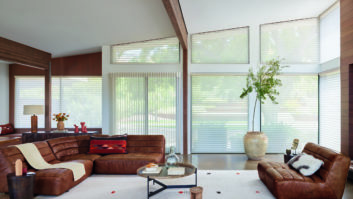f you build it, they will come, arriving by appointment or just walking in to savor the experience of a custom installation. For established companies, a well-appointed showroom can increase the dollar amount of many projects as clients discover the thrills of the latest technology and how it can enhance their homes.
For newer custom installation businesses, a showroom can provide an identity, validating market presence and instilling client trust. Showrooms also eliminate the need to intrude on existing customers whose home are often used as temporary showplaces for potential clients.
As with any business expansion however, business consultants caution that showroom planning requires a lot of forethought in regards to design, inventory and investment.
“A custom installer should be clear on what their showroom will cost and what its expected benefits will be,” said Doug Charlson, director of consulting for the CPA firm, Biggs, Kofford & Co., Colorado Springs, Colorado. “They should measure the results on an ongoing basis, asking themselves this question: ‘Did my investment help increase sales?’”
For Eric Bodley of Home Entertainment Design in Bonita Springs, Florida, the showroom path was clear and short. “My goal is to do as much on other people’s money as I can,” he said. “[But] I’m reluctant to go off the deep end.”
Bodley is in the process of adding showroom space without having to step outside his existing facility. He is designing an expansion in the other half of the building HED has occupied, as a tenant, for five years on US 41, a main thoroughfare between Ft. Myers and Naples. “We maxed out on our half of the building and we coerced, and paid, the tenant in the other half, a window tinting company, to move,” Bodley said.
HED currently has an Idea Lab, used to consult with clients, as well as two theater presentations, a Family Room and a dedicated theater with a Meridian digital system, Proceed, and Revel, both Madrigal products.
“We’re adding three more lifestyle offerings,” Bodley said. “One is a high-end theater with JBL Synthesis speakers, a Runco 1200 projector with a 440 processor. The other rooms feature a combination of Kenwood Sovereign, Snell and Meridian. One will be a “living room” with a functional fireplace, hidden speakers, plasma screen and a photo-like mural, lit up behind two windows.
Because many HED clients are wealthy retirees, one room will serve as a multi-functional activity area, featuring a computer, a Sony PlayStation 2 and XBox.
“We’ll have an open lobby/reception area to display the various technologies and to use for hosting events,” he said. “We recently hosted an architect’s seminar for Lutron at a hotel, but when you’re not at your own facility you can’t get them all jazzed up.” The expansion will allow HED to feature a broad selection of lighting controls and fixtures. “Clients from up north, who are used to basements which we don’t have here, want big open homes,” Bodley said. “We do a lot with lighting control and motorized treatments such as the VIMCO shades, to create a dark, theater environment. Expansion costs include about $30,000 to $50,000 for moving and ceiling treatments, he said. “The rest is all in equipment budgets with about a quarter million dollars in retail in our big theater. We’ve worked out good plans to spread our investment out over our lease.
The showroom expansion will help HED attract larger projects, Bodley said. “A lot of dealers can get to the two- to three-million mark in national sales and then run into a ceiling. I think one way to bust into the $10- to $15-million range is to do a showroom.” Bodley believes that if a custom installation firm can figure a way to operate without a showroom that can be a smart move, too. “It takes time to get that showroom investment back,” he admitted. “Most CEDIA members are not that well-capitalized. We waited.” For Heather and Jamie Sasser, owners of Digital Home Inc., in Raleigh, North Carolina, an invitation to open a showroom in a specialty home design center was the perfect proposal. Now entering its third year in business, Digital Home recently unveiled a 600-square-foot showroom inside the Raleigh Design Center (Kitchen and Bath Galleries), a 13,000-square-foot Mecca for homeowners in search of the latest cabinetry and wizardry for their homes.
Digital Home’s Egyptian blue and gold showroom, with a 16 x 22-foot dedicated home theater, was designed with help from Martha Dunnagan, owner of Dunnagan Design in Raleigh. It features Premiere navy blue leather reclining theater seats, faux-suede acoustical ceiling treatments, and First Impressions acoustical paneling. Rope lighting, washing the walls up and down, is concealed behind a band of acoustical paneling as well as by a tray ceiling. “We wanted a sophisticated-but-traditional look, an appealing style that would help attract women into the space,” Heather Sasser said. “Overall, there will be many showroom benefits; geographically it put us within one mile of our two biggest competitors, who have been in business for 20 years.”
A large mural on the Digital Home entrance wall will greet visitors to the showroom. A cabinet-enclosed television screen in the lobby will be coordinated with whatever is playing in the home theater. “Originally, we had a small, by-appointment showroom as part of our office, but we were separated from walk-in traffic areas,” said Heather Sasser. “When we were solicited by the Center, which was looking to expand and add custom electronics, it sounded like a great option for broadening our horizons.”
The horizons of potential clients also will be broadened, according to Jamie Sasser. “I’m constantly amazed by the number of people who are unaware of what you can do with electronics in the home,” he said. “Being in the Center allows us to get in front of those people who have the money, and would be interested if they knew what was available, including some people who are remodeling and looking for new appliances.”
Digital Home spent about $15,000 on wall installation, carpeting and furnishings. Equipment includes a Seleco projector, Macintosh processor and amplifier, Snell loudspeakers, Stewart screen, and Crestron controls.
“Our market is the $50,000 and up home theater/whole house A/V control systems segment,” Jamie Sasser said. “Crestron is a key component for us. Theater-only, and whole-house A/V-only clients typically spend $30,000 to 100,000. We top off at $200,000 to $250,000.
The Digital Home owners hope that she showroom will help establish credibility for them as the relatively new player in their market. “We certainly have sold some of our biggest jobs without this showroom, but people seem to feel better knowing we have one.” After more than 21 years without a showroom, Bill Skaer, president, CEO and partner of Eric Grundelman in Mesquite Texas, admits that opening a showroom is a good thing.
“I thought a showroom was a crutch for a weak salesman,” he said. “I’ve always tried to paint mental images of what a customer’s system would be, and our customers give us a lot of leeway. They’re largely people we’ve done business with for a long time or their friends.” At CEDIA EXPO last year, Skaer chatted with Brian Barr, president of California Audio Systems. “He told me about the success of a couple of other dealers with showrooms, and how it became easier for people to spend bigger dollars after being in one,” Skaer said. “I knew some people had gone into grotesque debt with these ‘monuments to themselves,’ and I wasn’t willing to spend the money.” But as last month’s Residential Systems Magazine cover story can attest, Skaer is now a convert. The Grundelman showroom, recently opened in a private airplane hangar, gives his company a leg up with clients, he said.
“The customer reaction is amazing,” Skaer noted. “The people who’ve come in were already customers, and I practiced on them. I raised the value of their systems by $30,000 to $100,000. At this point I can say without a doubt that you can do business without a showroom, but if you want to take it to the ‘big sandbox,’ you have to have one.” The Grundelman staff, now at 15, is poised to double over the next year, Skaer said. “The showroom will give us chance to put more projects on the board. The CEDIA board seminars helped me implement the showroom as well as some strategic planning. CEDIA management conferences gave me the spark, the push to go ahead and do something. It’s made the whole thing fun again. Guys who are timid now have a problem.”
Keeping one’s personal taste at bay during a showroom design can present a challenge, says Greg Margolis, president of HomeTronics in Dallas, Texas. After some 15 years of business success without a showroom, Margolis recently leased an additional 1,500-square feet next to his office for a dedicated, appointment-only, home theater/reception area.
Opened on February 1, the upscale beige and plum-colored showroom, at a total retail cost of about $650,000, was planned with the assistance of the Dallas-based architectural design and acoustical engineering firm, Russ Berger Design Group.
“You have to like what’s going in your showroom, but it’s so easy to drive yourself crazy over every detail,” Margolis admitted. “My taste runs to the contemporary–black and metal–but I know better, that most of my clients don’t share that.”
The new HomeTronics showroom, with a Corian wet bar, Italian bathroom tile, architectural lighting and sheet rock ceilings, was furnished to achieve a “non-showroom” ambiance It is a showplace for elite lines such as Runco, California Audio Technology and ADA. “The showroom is split into two sections,” Margolis said. “The eight-seat home theater has three LCR speakers, six surrounds, and 12 subwoofers. The reception area, with the wet bar, has one pair of $150,000 CAT 1033 speakers.”
The space is engineered for this one CAT application, Margolis says. “Crossovers are built for each speaker, and speakers are laid out, placed specifically on seating positions and according to room dimensions. CAT is the only residential manufacturer involved in active bass balancing control, using multiple subwoofers throughout the room.”
Chair of the CAT MBX Protocol Committee, Margolis said several other CAT dealers would be opening showrooms of this caliber in 2002. “CAT MBX is made up of an elite group of dealers who have put together guidelines for doing home theaters, incorporating acoustics and all the elements to make sure the process is done correctly from start to finish,” he said. “Without seeing or experiencing this type of system, you can’t comprehend how incredible it is.”
Margolis says current and future marketing plans convinced him to launch a showroom. “We’ll hold events and “after 6″ receptions with architects, builders and decorators,” he explained. “Our clientele are not affected by the overall economy. No one else that I know of has gone to this extent in a showroom, and we’re really jazzed about it.”
Premier Home Theater, the Washougal, Washington, custom installation firm featured in the December issue of Residential Systems magazine, had so many clients with homes in western Montana, principals Jason Carnahan and Rick Sant decided to open their first showroom in Missoula.
“Most of our work–all high-end–is in western Montana, Wyoming and southern California, Carnahan said. “We end up doing second and even third homes for these clients in Pasadena, L.A. and in the desert.” The Washougal office is more of a warehouse, with Carnahan’s own home doubling as a showroom, filled with large photos of Premier designs and installations.
“We’re not selling the product as much as we are ourselves; our clients are buying us and our expertise,” he said. “But we lacked being able to show the touch and feel of our work, and although clients were buying on our recommendations, some opted not to get as many touch screens until they could see it all working, see how the plasma screens pops up from a lift.”
The 1,500-square-foot Premier showroom features equipment and corner vignettes with a variety of wall colors, fabrics and furnishings. Three styles of theater chairs and columns give a taste of what a home theater could be.
The whole room carries a classy Western theme with pine wainscoting with trim and moldings, Carnahan said. “We have an active Lutron lighting system, motorized shades, a motorized Runco plasma screen on a popup lift, all in a small space,” he noted.
Tables in the lounge area feature different styles of seating from Cinematech. Another table is made of hammered metal with glass. “We also have a game room area with a custom-built, log leg, table and electronics from Monte Carlo, in Spokane,” Carnahan said. “Our initial investment for the showroom, located in a rental space, was about $65,000.
“It was time for this showroom,” Carnahan added. “Ryan Prentice, VP of our Montana Division, moved to Missoula two years ago, and we were getting more and more jobs there. It’s in our plans to do more showrooms like this in the future.”
Karen Mitchell is a writer based in Boulder, Colorado.
